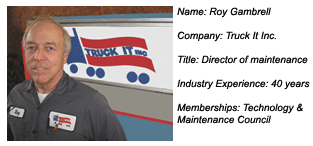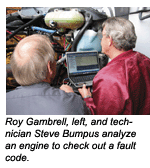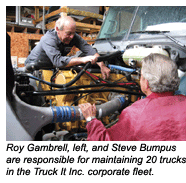Truck It’s Roy Gambrell says predictive maintenance, flexibility and standardization with vendors are musts in a small shop

Performing best practices in a small shop can be a challenge. Just ask Roy Gambrell, director of maintenance at Truck It Inc., a Franklin, Ky.-based flatbed carrier that operates in 48 states and Canada.
After all, at small companies there are fewer people to spread the workload among and corporate resources are sparse. In fact, when the company needs to hire a techician, it goes to Gambrell. Need to spec a truck, talk to Gambrell. Need to schedule maintenance, that would be Gambrell. Need to meet with suppliers, it’s Gambrell again.
Gambrell also regularly works as a technician, which is work he’s been doing for 40 years, including 20 at Truck It. The company, owned by Steve Ligon, has one other technician, Steve Bumpus, who has been with the company 16 years. Together, they maintain 20 trucks for the company’s 18 drivers.
“We work a flexible schedule, based on the needs of the company,” Gambrell says. “Typically we start at 7 a.m. and leave at 5 p.m. But sometimes we need to be here at 4 a.m. to turn around a truck, and may have to stay until 7 p.m. But the next day or two, we may not come in at all, depending on the schedule. The work determines our schedule.”
Bumpus and Gambrell have been working together so long that team building has occurred naturally.

“You build a solid relationship when you work together all the time,” Gambrell says. “We’ve been working together so long that sometimes we know what each other is going to do before we do it.”
It helps that neither of them shy away from work. “We are both old school and believe in a solid day’s work for a solid day’s pay,” Gambrell says. “We also believe in fixing things before they break.”
An important part of best practices for Gambrell is predictive maintenance. With 40 years of experience as a technician, he’s built a formidable database on how long truck components can be expected to last and he has a preference for those parts.
“I use predictive maintenance to foretell when a problem will happen based on past experience,” he says. “I used to be able to tell you when a headlight or air compressor was going to fail, but there are so many different bulbs and parts now, that’s more difficult to do.”

Constantly changing parts undermines his database, which he says needs at least seven years of record keeping to be reliable. “I started spec’ing in 1987, and by 1994, I had a good idea about how long certain parts were going to last,” Gambrell says.
But some of those parts are getting more difficult to spec.
“It’s hard to spec a truck like I want to because truck manufacturers are trying to cut their costs by using one or two parts for every truck,” he says. “My spec options have been cut, but the prices of trucks continue to rise.”
But that doesn’t stop him from getting certain parts he wants on the company’s new vehicles.
“I’ll pay extra money to spec a truck the way I want it,” Gambrell says. “If I can’t spec what I want, the first thing I do when I get a new truck is to change all the hoses, fuel filters, hose clamps, airlines, fittings and wiring. If I do it up front, I’ll save in the long run because my expectations go beyond the typical warranty that is offered today.”
He says he routinely used to get
1 million miles out of certain clutches and linings, drivelines, transmissions and rear wheel seals. Having those trusted vendor’s parts on his company’s fleet allows him to perform routine maintenance and keep downtime to a minimum. While his efforts and predictive maintenance practices are not perfect, the company’s trucks seldom break down on the road, according to Gambrell.
The company sticks to one preferred tractor and trailer supplier to keep inventory costs and training requirements under control.
“We run the same trucks and get familiar with them so we don’t have to stop and read manuals while we are working.”
When model changes occur, vendors are more than willing to provide training on site or electronically, he says.
Defining what a small company can’t do is an important step in performing best practices. Trying to do too much can be overwhelming.
“We don’t do body shop work for environmental reasons,” Gambrell says. “We keep spare parts, so we’ll swap out hoods or bumpers, but we don’t have a paint spray booth and we don’t wash our trucks because environmental issues are a great concern.”
Alignment work also is outsourced. “Alignment equipment is expensive,” he says. “We can’t justify that expense for 20 trucks.”
Gambrell credits the Technology & Maintenance Council as being a great equalizer between large and small fleets. “When I approach a vendor or bring up an issue at TMC, I’m treated the same as the mega fleets,” he says. If you have trucks, you need to participate in TMC.”
